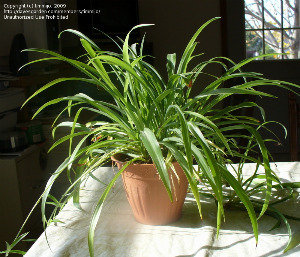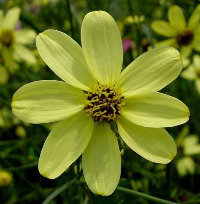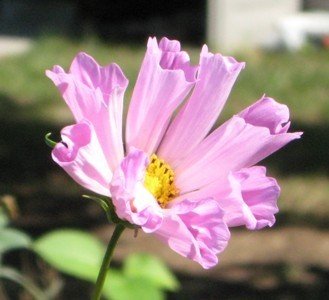





I wasn't raised to be a religious person, although I now go to church fairly regularly. I'm not sure if I believe in God or not; sometimes I do, fervently, sometimes I don't. But when I think about the wonder of a seed ... it's hard not to be awe-struck and amazed.
I didn't used to believe in seeds, not really. I mean, they certainly sold a lot of them, and I even confess to buying quite a few of these mysterious items. The pictures on the packets were alluring, promising a far lovelier garden than I had, and they were relatively inexpensive! But as for what to do with them, well, frankly, I had very little idea.My first experience with seeds happened on the back of a tractor, "helping" my cousins help their parents on their farm outside Washington, DC. An older cousin would drive the tractor along a field of red dirt which was already prepared: weeded, layered with compost, plowed, etc. All that remained was to make a hole and stick the seed in it. This was the job of the elementary school-age children, to ride on the plow and drop in the seeds, coated with something brightly colored and powdery, probably fertilizer or pesticide; these were serious, working farmers, you understand. Anyway, the child's job was to drop one seed in each row every so often, whatever pre-assigned distance we were told. I think what I am remembering must have been squash seeds, based on what I now know about the time of year and the size of the seeds and so on. These were big seeds coated in bright pink or purple substance. (All farm terms may be wrong!)
 Since that fuzzy long-ago time, I seem to have grown up. First, I had potted plants in apartments, then in a house, and ultimately, I looked outside the house to the yard. I started by just bringing my potted plants outside for the summer, next I planted a few perennials in pots and left them outside year-round. Meanwhile, I kept buying those pretty seed packages. Now I knew, for instance, that spider plants made baby spider plants (without resorting to seeds) and that there were other obvious examples of non-seed (or asexual) reproduction existing in nature. It was possible to get by without seeds at all. (For example, think of crocuses spreading in the yard, any bush or tree that puts out suckers, that weed you pull that grows back from the tiniest scrap of root, or dandelions spreading). Still, seeds themselves eluded me. There was something I wasn't quite figuring out.
Since that fuzzy long-ago time, I seem to have grown up. First, I had potted plants in apartments, then in a house, and ultimately, I looked outside the house to the yard. I started by just bringing my potted plants outside for the summer, next I planted a few perennials in pots and left them outside year-round. Meanwhile, I kept buying those pretty seed packages. Now I knew, for instance, that spider plants made baby spider plants (without resorting to seeds) and that there were other obvious examples of non-seed (or asexual) reproduction existing in nature. It was possible to get by without seeds at all. (For example, think of crocuses spreading in the yard, any bush or tree that puts out suckers, that weed you pull that grows back from the tiniest scrap of root, or dandelions spreading). Still, seeds themselves eluded me. There was something I wasn't quite figuring out.
Then I noticed the reproduction by seeds that occurs in nature, without our help at all! Dandelions, for instance, reproduce both ways; not only asexually, by underground roots that are impossible to dig out, but also by those fluffy white airborne seeds that children blow everywhere. Or that maple tree that I swear has 125% germination rate, I am forever weeding sprouts, seedlings, saplings, and I even have a huge tree in my back yard that was a seedling nobody caught. The Coreopsis 'Moonbeam' that is now endemic in my yard. These are all evidence that seeds must work! They work in nature, they work for farmers, they work for commercial greenhouses, and I'm here to tell you that they can work for you, too!
I think seeds are magical. I never took anything other than 7th grade biology (which boys and girls had to take separately due to the inflammatory nature of the curriculum); I don't know how seeds work. But, ladies and gentlemen, they do work. Somehow, each tiny speck of a seed knows whether it is supposed to be a cleome or a cosmos, and even if you label them incorrectly, the right flower will grow! I'm a big fan of labels—I label shelves in the linen closet so the sheets will know which shelf to fly to (this hasn't worked yet) and I monogram towels so each family member will use only his or her towel (this hasn't worked yet either). Well, I usually have had bad luck labelling my seeds—I've been lulled into a false sense of security by "waterproof" pens that can't stand up to the weather and find that I'm too clumsy to write legibly with my weatherproof paint pen. But it doesn't matter—seeds know what they are supposed to be! If I am patient enough to wait for the  telltale foliage to show, and if I've been experimenting long enough to recognize the foliage, then I'm safe.
telltale foliage to show, and if I've been experimenting long enough to recognize the foliage, then I'm safe.
Now, there's one caveat: I'm not yet sure that I can make seeds work in a garden in the ground. Most of my flowers are perennials I purchased or seeds I've planted in containers. You see, I live at the bottom of a hill, and everyone else on our street uses a yard service to chemically fertilize, a yard service to chemically kill the "weeds" (anything other than grass), a yard service to chemically kill the bugs, good or bad, a service to mow and rake and take the leaves and grass clippings away and then turn around and charge the people for mulch and fertilizer. I worry about the result of all those chemicals washing down the street to my dirt, which contains a lot of construction debris to begin with. That that is why I am afraid to eat anything grown in my dirt, and why I trust the soil in my containers more than in the ground. Then in this state of disbelief and mistrust, I tried winter sowing.
Winter sowing consists of trying to replicate the effects of nature's wind, rain, sun, snow, freezing and thawing on a seed. The seeds and approximately 4 inches of potting soil are placed in something like a plastic 1-gallon milk jug with drainage holes punched in the top and bottom. They are protected in their mini-homes from hungry critters, from torrential rain storms and from drying totally out. I emphasize the something like a plastic milk jug because winter sowing can be done in all kinds of containers, provided there is room for the 4 inches of soil and the ventilation and drainage holes. This works best on seeds which are seeds for perennials, seeds like morning glories with hard outer coats, and seeds like bachelor buttons, which tend to self sow anyway. With winter sowing you stick your carefully prepared containers out in winter (some stick 'em out on the Winter Solstice!) and then let them fend for themselves until spring, People do this in Texas and Florida but they don't get the benefit of the freezing layers of snow in December, the thaws in January, and the subsequent hard freezes and snow again in February that we get.
When you see instructions for sowing a seed that read like this: "first freeze the seed for six weeks. Then move to 50° F for five weeks, then return to 30° for two weeks, then place at 70° until you observe germination," what does that sound but like but New England winter and spring? Well, I've seen instructions like that! Those are seeds that can definitely be winter sown.
Anyway, with great trepidation, I started winter sowing. Although I had barely ever sown a seed successfully in my life, I discovered that those mysterious little crumbs or pieces of dust actually contain the genetic material for an entire plant! I already believed, as you probably do, that every single cell of an animal or human contains all the genetic material necessary for cloning that animal; we just don't have the technology (nor do we want to). But were plants that sneaky too , that you could grow a entire plant from one little tiny seed? Outrageous! I followed the instructions for winter sowing carefully, as I might a new, untried recipe. Imagine my surprise when that spring, lo and behold, I had jugs full of zillions of seedlings!
, that you could grow a entire plant from one little tiny seed? Outrageous! I followed the instructions for winter sowing carefully, as I might a new, untried recipe. Imagine my surprise when that spring, lo and behold, I had jugs full of zillions of seedlings!
So, amazingly, winter sowing worked. It was a way--if a slightly tedious one--of making seeds turn into plants (miraculous all by itself). But sometimes I didn't want to go to the trouble of saving milk jugs and I really couldn't write neatly with the cumbrsome paint pens required for really good labelling. Next I started sowing seeds in the spring in the pots where I wanted them to grow. It worked! I sowed nasturtium seeds in the huge boxes full of potting soil where the roses had been over-zealously cut back. They grew there too! Amazing!
I don't understand how, exactly, the information is squeezed into a tiny seed about what kind of flower to be, large or small, red, yellow or purple, tall or trailing. I've cut a swollen bulb open and seen the tiny flower coiled inside, ready to spring out. Clearly there CAN'T be a tiny flower packed inside my flower seeds, or a tiny pumpkin packed into each pumpkin seed. I cannot explain the diagram in the thumbnail picture; I don't know what b, c and d represent. I maybe could learn if I took the time and if I weren't running out of brain space at such a rapid rate. But it is a lovely thing to realize, that these seeds will make Cosmos bipinnatus 'Seashells' in soft pastels with unusual curled petals (picture left) and those other ones, which to me look exactly the same, will make the same flower but it will be Cosmos sulphureus with orange, yellow and red flowers and plain petals. How do they know which to be without a label? Miraculous!
Seeds, however they work, are truly a miracle. They are awe-inspiring to watch, they are evidence of the majesty of nature crammed in to a tiny package. They are, as my teengers would say, "awesome."
PICTURE CREDITS: PlantFiles photos of spider plant courtesy of timmijo and of Coreopsis "Moonbeam' courtsey of htop. Thank you! I actually took the Cosmos photo myself.
Dave's Garden SUBSCRIBERS will find lots more information about winter sowing on the Winter Sowing Forum and about propagation on the Propagation Forum!
(Editor's Note: This article was originally published on August 2, 2010. Your comments are welcome, but please be aware that authors of previously published articles may not be able to respond to your questions.)
Copyright © www.100flowers.win Botanic Garden All Rights Reserved